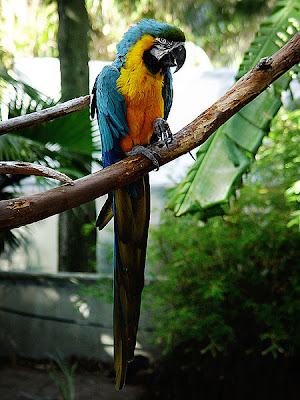Description
It can reach 76–86 cm (29.9-33.9 inches) long and weigh 900 to 1300 g (2-3 lbs). It is vivid in appearance with blue wings and tail, dark blue chin, golden under parts and a green forehead. Its beak is black, and very strong for crushing nuts. The naked face is white, turning pink in excited birds, and lined with small black feathers.
There is little variation in plumage across the range. Some birds have a more orangey or "butterscotch" underside color, particularly on the breast. This was often seen in Trinidad birds and others of the Caribbean area, and appears to be due to environmental factors. The Blue-and-yellow Macaw uses its powerful beak for breaking nutshells, and also for climbing up and hanging from trees.
Breeding
The Blue-and-yellow Macaw generally mates for life. It nests in a tree hole and the female typically lays two or three eggs. The female incubates the eggs for about 28 days, and the chicks fledge from the nest about 90 days after hatching.
Aviculture
Blue-and-yellow Macaws are popular as pets partly because of their striking appearance and ability as a talking bird; however, their large size makes accommodation problematic, and they require much more effort and knowledge from owners than more traditional pets such as dogs or cats. They are intelligent and social, so for someone who can provide for their needs, they make good and loving companion parrot. Blue-and-yellow Macaws bond very closely to their owners. They tend to be more aggressive during mating season, typically 6–8 weeks in the spring time.
Even the most well cared for Blue-and-yellow Macaw will "scream" and make other loud noises. Loud vocalizations, especially "flock calls", and destructive chewing are natural parts of their behavior and should be expected in captivity.
They require a varied diet, a seed only diet will lead to health problems such as vitamin deficiency. An example of a good diet would be a quality pelleted mix, in conjunction with a mix featuring seed, nuts, and dried fruits, with fresh vegetables (greens and roots) and fruits fed regularly; furthermore, it is quite common (and appreciated by the parrot) to partake with their human owners of safe foods like pasta, bread, etc.
It is important to avoid foods with high fat content (generally) while striving to provide a wide variety of foods. There are some foods which are toxic to birds and parrots as a group. Cherries and most other Rosaceae pits and seeds, avocados, chocolate, and caffeine are among the foods toxic to parrots. Chocolate and caffeine are not metabolized by birds the same way they are in humans. Rosaceae seeds contain cyanogenic glycosides, and avocados contain persin which are both toxic compounds to birds. Safe foods include oranges, apples, grapes, peanuts, walnuts and sunflower seeds.
 RSS Feed
RSS Feed
 Wednesday, October 21, 2009 |
Wednesday, October 21, 2009 | 






0 comments:
Post a Comment